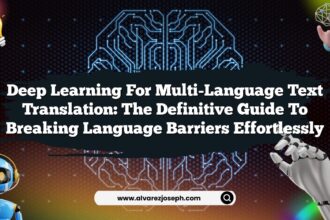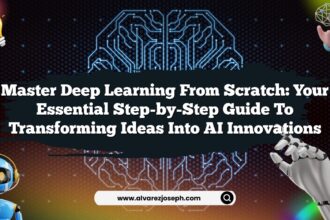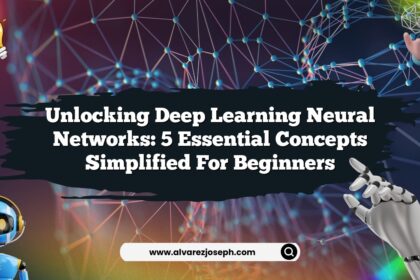Imagine waking up one day, and instead of scrolling through social media, you’re analyzing big data sets, predicting trends, and creating algorithms that could revolutionize industries. Sounds like a dream, right? Well, it doesn’t have to be just a fantasy. With the right knowledge and skills, you can kickstart your data science career today, and deep learning is the hot topic that could get you there.
Deep learning isn’t just a buzzword thrown around at tech conferences; it’s the backbone of the most innovative applications in artificial intelligence today. From self-driving cars to personalized recommendations, deep learning models are everywhere, and understanding them could set you apart in a competitive field. So, are you ready to dive in? Let’s explore seven essential deep learning tutorials that will provide you with a solid foundation and perhaps open the door to your future career in data science.
Understanding the Basics of Deep Learning
Before we jump into the tutorials, let’s demystify what deep learning really entails. In essence, deep learning is a subset of machine learning where algorithms are inspired by the structure and function of the brain, known as artificial neural networks. But don’t let the technical jargon scare you away! Picture a network of neurons working together to process vast amounts of data and you’re halfway there.
What Makes Deep Learning So Powerful?
Deep learning is powerful because it can identify patterns in data that traditional algorithms simply can’t. For instance, while a standard algorithm might struggle to differentiate between a cat and a dog in photos, a well-trained deep learning model can analyze the images in multiple dimensions and learn from them. This capability is what makes deep learning a game-changer in fields such as healthcare, finance, and entertainment.
1. Deep Learning Specialization on Coursera
Ready to get your feet wet? The Deep Learning Specialization offered by Andrew Ng on Coursera is a fantastic starting point. This series of five courses teaches you the fundamentals of deep learning, helping you build a solid understanding of neural networks, convolutional networks, and more.
- Format: Video lectures, quizzes, and hands-on projects.
- Duration: Approximately 3 months at a pace of 5 hours per week.
- Cost: Free to audit, with a fee for certification.
What’s more, Ng’s teaching style is engaging and accessible, breaking down complex concepts into digestible chunks. But wait, does it really prepare you for the real-world challenges you’ll face? Absolutely! By the end, you’ll have a portfolio of projects showcasing your skills—talk about a career booster!
2. Fast.ai’s Practical Deep Learning for Coders
Fast.ai’s Practical Deep Learning for Coders course is a gem for those who prefer a hands-on approach. It’s designed for people with some coding experience but no extensive background in machine learning.
- Format: Jupyter notebooks and practical exercises.
- Duration: 7 weeks, with a commitment of around 10 hours per week.
- Cost: Free!
This course emphasizes getting your hands dirty right from the start. You’ll be building models on real datasets, which is a fantastic way to learn. Plus, it’s community-driven, meaning you’ll have support whenever you hit a roadblock. But be warned: once you start, you might find yourself lost in a vortex of coding and creativity!
3. Deep Learning with Python and PyTorch
Python is the go-to language for many data scientists, and when it comes to deep learning, PyTorch is an essential tool. The book “Deep Learning with Python” by François Chollet is an outstanding resource. It provides a clear introduction to both the theory and practical applications of deep learning using Keras and TensorFlow.
- Format: Theoretical insights paired with code examples.
- Duration: Self-paced.
- Cost: Check local libraries or online platforms for availability.
Reading this book will not only equip you with the knowledge to build neural networks but also enhance your understanding of the underlying principles. You’ll feel like you’re pulling the strings behind the curtain of AI. Imagine the bragging rights at your next dinner party!
4. CS231n: Convolutional Neural Networks for Visual Recognition
If you’re intrigued by how computers can recognize images (think of how your phone recognizes your face), then Stanford’s CS231n is where you need to be. This course dives deep into convolutional neural networks (CNNs), which are crucial for image processing.
- Format: Lecture notes, assignments, and a final project.
- Duration: Approximately 10 weeks at a pace of 10 hours per week.
- Cost: Free!
This course is rigorous but extremely rewarding. You’ll tackle real-world computer vision challenges, and the academic environment will push you to think critically. Curious about how CNNs are applied in self-driving cars? This course has the answers, and you’ll be equipped to contribute to such innovations!
5. Deep Reinforcement Learning Course by UCL
Moving beyond supervised learning, the field of reinforcement learning is a frontier in machine learning. The Deep Reinforcement Learning course from University College London covers the principles of reinforcement learning and its applications.
- Format: Lectures, practical coding assignments, and research papers.
- Duration: Self-paced.
- Cost: Free!
Reinforcement learning can seem a bit like training a pet—reward the behavior you want and discourage the rest. This course will teach you how to develop algorithms that learn from their environment and improve over time. Are you ready to unleash your inner AI trainer?
6. Hands-On Machine Learning with Scikit-Learn, Keras, and TensorFlow
Another fantastic resource is the book “Hands-On Machine Learning with Scikit-Learn, Keras, and TensorFlow” by Aurélien Géron. This book isn’t exclusively about deep learning, but it covers essential machine learning concepts and practical implementations in Python.
- Format: In-depth explanations paired with practical exercises.
- Duration: Self-paced.
- Cost: Check online retailers or libraries for purchase options.
The blend of theory and practical coding examples will have you building your machine learning models in no time. Plus, the hands-on approach means you can experiment with your projects, making learning feel less like a chore and more like an adventure. Who knew learning could be so fun?
7. Deep Learning for NLP with PyTorch
Natural Language Processing (NLP) is revolutionizing how we interact with technology. The Deep Learning for NLP with PyTorch by the Hugging Face team is a must-try for anyone keen on understanding how machines comprehend human language.
- Format: Video tutorials and hands-on projects.
- Duration: Self-paced.
- Cost: Free!
This tutorial dives into state-of-the-art models like transformers and BERT. You’ll not only learn how to build NLP models but also understand the underlying theories. Did you ever think you could teach a machine to understand sarcasm? Spoiler alert: it’s a work in progress!
Quick Summary
- Deep Learning Specialization on Coursera offers foundational courses, accessible learning, and real-world applications.
- Fast.ai’s Practical Deep Learning for Coders emphasizes hands-on experience from day one.
- Deep Learning with Python and PyTorch provides a clear and thorough understanding through a practical lens.
- CS231n from Stanford focuses on convolutional neural networks for visual recognition.
- Deep Reinforcement Learning Course by UCL explores reinforcement learning principles and applications.
- Hands-On Machine Learning with Scikit-Learn, Keras, and TensorFlow blends theory and practical coding for machine learning applications.
- Deep Learning for NLP with PyTorch showcases how machines can understand and generate human language.
Frequently Asked Questions
What is deep learning?
Deep learning is a subset of machine learning involving neural networks that process data in layers to identify patterns and make decisions.
Do I need a strong math background to learn deep learning?
While some mathematical knowledge is beneficial, many resources teach the concepts in an accessible manner, so don’t let math anxiety deter you!
What programming language should I learn for deep learning?
Python is the most popular language in data science and deep learning, with libraries like TensorFlow and PyTorch making it easier to implement algorithms.
How long does it take to learn deep learning?
The time varies depending on your prior knowledge and dedication, but you can start building projects in a matter of months.
Can I transition to a data science career without a tech background?
Absolutely! Many resources cater to beginners, and with dedication and practice, you can build the necessary skills.
Are online courses enough to land a job in data science?
While online courses provide foundational knowledge, practical experience through projects and a robust portfolio plays a crucial role in job readiness.
By now, you should feel excited and equipped to embark on your deep learning journey. The resources mentioned above can help you grab that elusive data science job. Remember, it’s all about persistence, practice, and a bit of curiosity. And who knows? You might just be the next big thing in AI innovation!












